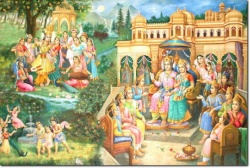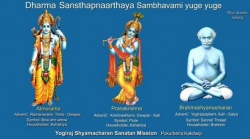Yuga
Yuga (Devanāgari: युग) in Hindu philosophy is the name of an 'epoch' or 'era' within a cycle of four ages. These are the Satya Yuga, the Treta Yuga, the Dvapara Yuga, and finally the Kali Yuga. According to Hindu cosmology, life in the universe is created and destroyed once every 4.1 to 8.2 billion years, which is one full day (day and night) for Brahma. The lifetime of a Brahma himself may be 311 trillion and 40 billion years. The cycles are said to repeat like the seasons, waxing and waning within a greater time-cycle of the creation and destruction of the universe. Like Summer, Spring, Winter and Autumn, each yuga involves stages or gradual changes which the earth and the consciousness of mankind goes through as a whole. A complete yuga cycle from a high Golden Age of enlightenment to a Dark Age and back again is said to be caused by the solar system's motion around another star.
Kalki
Lord Vishnu has many avatars and in each yuga, he has revealed all of them except-the last avatar(tenth)-Kalki. It is said that in the last yuga Lord Vishnu will reveal this avatar too and the Kalki avatar will lead to the end of the world. The main reason is to destroy the wicked, to restart the new creation, and to restore the purity of conduct in people's life. This avatar will be seated in a white horse with a drawn sword blazing like a comet. Earlier that White horse came from the Third eye of the lord Shiva in the form of fire that has been converted into the White Horse by Lord Brahma.
Durations of four yugas
According to the Laws of Manu, one of the earliest known texts describing the yugas, the length is 4800 years + 3600 years + 2400 years + 1200 years for a total of 12,000 years for one arc, or 24,000 years to complete the cycle (one precession of the equinox). There is no mention of a year of the demigods or any year longer than the solar year, which is consistent with description in The Holy Science. However, the more recent and popular interpretation from the Srimad Bhagavatam states the following: "The duration of the Satya millennium equals 4,800 years of the years of the demigods; the duration of the Dvāpara millennium equals 2,400 years; and that of the Kali millennium is 1,200 years of the demigods... As aforementioned, one year of the demigods is equal to 360 years of the human beings. The duration of the Satya-yuga is therefore 4,800 x 360, or 1,728,000 years. The duration of the Tretā-yuga is 3,600 x 360, or 1,296,000 years. The duration of the Dvāpara-yuga is 2,400 x 360, or 864,000 years. And the last, the Kali-yuga, is 1,200 x 360, or 432,000 years in total." (Śrīmad Bhāgavatam 3.11.19). These 4 yugas follow a timeline ratio of (4:3:2:1).
MANVANTARA=MAHAYUG*71
|
|---|
| MANVANTARA | [1200(4*360)+1200(3*360)+1200(2*360)+1200(1*360)]*71 |
| MAHAYUG | [1200(4*360)+1200(3*360)+1200(2*360)+1200(1*360)] |
The ages see a gradual decline of dharma, wisdom, knowledge, intellectual capability, life span, emotional and physical strength.
- Satya Yuga:- Virtue reigns supreme. Human stature was 21 cubits. Average human lifespan was 100,000 years.
- Treta Yuga: – There was 3 quarter virtue & 1 quarter sin. Normal human stature was 14 cubits. Average human lifespan was 10,000 years.
- Dwapar Yuga: – There was 1 half virtue & 1 half sin. Normal human stature was 7 cubits. Average human lifespan was 1000 years.
- Kali Yuga: – There was 1 quarter virtue & 3 quarter sin. Normal human stature was 3.5 cubits. Average human lifespan will be 100 years. Towards the end of the Yuga this will come down to 20 years.
While the long yuga count is the most popular it does not correlate to any known celestial motion found in the Astronomical Almanac. The value of 24,000 years is within 7% of the modern astronomical calculation of one full precession of the equinox of 25,772 years. This phenomenon is observed as the stars moving retrograde across the sky at about 50 arc seconds per year and is thought to produce periods of warm ages and ice ages known as the Milankovitch cycle, thus the yuga cycle may have some basis in known terrestrial cycles.
Sri Yukteswar's teachings on the yugas
The long count view of the yuga cycle with its vast time scale was challenged by the 19th/20th-century Indian yogi Swami Sri Yukteswar Giri, guru of Paramahansa Yogananda.
In his book, The Holy Science, Sri Yukteswar explained that the descending phase of Satya Yuga lasts 4800 years, the Treta Yuga 3600 years, Dwapara Yuga 2400 years, and the Kali Yuga 1200 years. The ascending phase of the Kali Yuga then begins, also lasting 1200 years. The ascending phase of the Kali Yuga began in September 499 AD. Since September 1699, we have been in the ascending phase of the Dwapara Yuga, according to Sri Yukteswar.
In The Holy Science, Sri Yukteswar wrote that the traditional or long count view is based on a misunderstanding. He says that at the end of the last descending Dvapara Yuga (about 700 BC), "Maharaja Yudhisthira, noticing the appearance of the dark Kali Yuga, made over his throne to his grandson [and]...together with all of his wise men...retired to the Himalaya Mountains... Thus there was none in the court...who could understand the principle of correctly accounting the ages of the several Yugas."
According to Sri Yukteswar, nobody wanted to announce the bad news of the beginning of the descending Kali Yuga, so they kept adding years to the Dvapara date (at that time 2400 Dvapara) only retitling the epoch to Kali. As the Kali began to ascend again, scholars of the time recognized that there was a mistake in the date (then being called 3600+ Kali, even their texts said Kali had only 1200 years). "By way of reconciliation, they fancied that 1200 years, the real age of Kali, were not the ordinary years of our earth, but were so many daiva (or deva) years ("years of the gods"), consisting of 12 daiva months of 30 daiva days each, with each daiva day being equal to one ordinary solar year of our earth. Hence according to these men 1200 years of Kali Yuga must be equal to 432,000 years of our earth."
Sri Yukteswar explained that just as the cycle of day and night is caused by a celestial motion (the earth spinning on its axis in relation to the sun), and just as the cycle of the seasons are caused by a celestial motion (the earth with tilted axis orbiting the sun) so too is the yuga cycle (seen as the precession of the equinox), caused by a celestial motion. He explained this celestial motion as the movement of the whole solar system around another star. As our sun moves through this orbit, it takes the solar system (and earth) closer to and then further from a point in space known as the "grand centre" also called 'Vishnunabhi', which is the seat of the creative power, 'Brahma', [which]...regulates...the mental virtue of the internal world." He implied that it is the proximity of the earth and sun to this grand centre that determines which season of man or yuga it is.
Quoting from The Holy Science, Sri Yukteswar states that our sun revolves round a grand center called Vishnunabhi, which is the seat of the creative power, Brahma, the universal magnetism. Brahma regulates dharma, the mental virtue of the internal world. Sri Yukteswar states: ...the sun, with its planets and their moons, takes some star for its dual and revolves round it in about 24,000 years of our earth.... Essentially, When the sun in its revolution round its dual comes to the place nearest to this grand center, the seat of Brahma...the mental virtue, becomes so much developed that man can easily comprehend all, even the mysteries of Spirit." Further, ...when the sun goes to the place in its orbit which is farthest from Brahma, the grand center...the mental virtue, comes to such a reduced state that man cannot grasp anything beyond the gross material creation. Paramahansa Yogananda, devotee of Sri Yukteswar, dates his forward in the book as 249 Dwapara (1949 AD). The period of 2400 years during which the sun passes through the 2/20th portion of its orbit is called Dwapara Yuga. Dharma, the mental virtue, is then in the second stage of development and is but half complete; the human intellect can then comprehend the fine matters of electricities and their attributes which are the creating principles of the external world.
The four yugas and Brahmajnana
It should be obvious that the life style in the four Yugas is the same as life style of people of the four Hindu Varnas.
- Krita/Satya Yuga – Brahmana Varna
- Treta Yuga – Kshatriya Varna
- D(v/w)apara Yuga – Vaishya Varna
- Kali Yuga – Shudra Varna
The Varna of a person is determined by the two attitudes, Positive and Negative,
- Brahmana Varna – Positive and Negative attitudes merge to become one and the same
- Kshatriya Varna – Positive and Negative attitudes are separate
- Vaishya Varna – There is just Positive attitude and no negative attitude
- Shudra Varna – The two attitudes are absent.
Brahmana Varna gives best quality of life and authority but can be used under ideal conditions only. All activities of life are interlinked and eternal. This forces Brahmana to be honest. Shudra Varna gives maximum freedom but least quality of life. In this Varna all activities are independent of each other and transient. The enormous flexibility makes it the ideal Varna for chaotic conditions. The Varnas were banned because Hindus tried to have both the authority of Brahmana Varna and the freedom of Shudra Varna. The Varnas were therefore, replaced with the Virtual Yugas.




